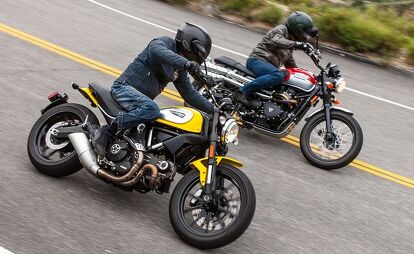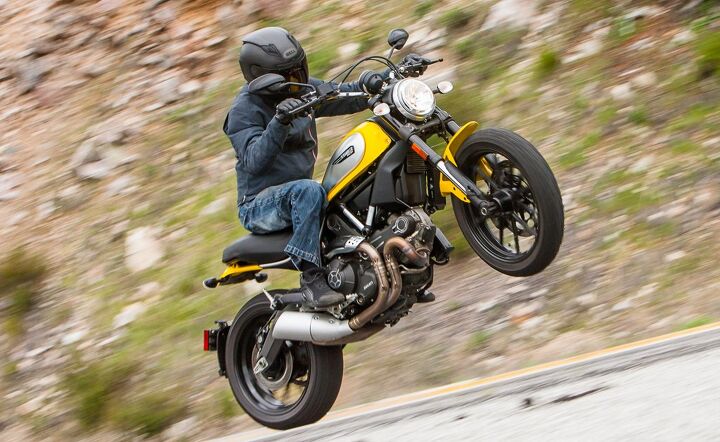Scrambler Slam: Ducati Vs Triumph + Video
Two bikes, mildly tuned, heavy on the nostalgia sauce
What’s a scrambler? In decades past, a scrambler was a street motorcycle stripped down and optimized for off-road use by way of swapping-in high-pipes, wider handlebars, semi-knobby tires, and differently styled fenders, seat and tank. Sometimes, it was an unmodified street model given a scrambler or street scrambler designation. In essence, it’s a cool name meant to convey agile sportability regardless of the bike’s dirt or street intentions.
Recently, Scrambler’s been the name affixed to a modern throwback Triumph that’s been playing in its own sandbox for years. Ducati finally took notice of Triumph’s cornering of the scrambler market and, having scrambler models in its own historical record, decided to expand the segment with not just one scrambler model, but with four: Icon, Urban Enduro, Classic and Full Throttle.
We’ve solo-tested the Triumph Scrambler, most recently in 2012 by EiC, Kevin Duke, while Troy Siahaan conducted a first-ride review of Ducati’s scrambler models as recently as last December, at the press launch in Palms Springs, California.
Bringing together these scramblers from competing OEMs has been our goal, which we’ve now realized in the Ducati Scrambler Icon and Triumph Scrambler. Both bikes adhere to, and extoll the values of, their predecessors, but which Scrambler is the better one to scramble upon? That depends on which definition of scrambler you prefer.
Although Triumph never had a model specifically named Scrambler until this modern iteration, it is the scrambler here Steve McQueen would best recognize. Seemingly beamed directly from 1967, the Triumph Scrambler epitomizes the high-pipe, wire-wheeled on/off-roaders of yore.
The Scrambler Icon, on the other hand, is a modern interpretation of scramblers from Ducati’s past, but if you compare the modern with the original, the new bike bleeds its heritage from most angles, with mag wheels, upswept exhaust and V-Twin engine being the most obvious differences. Also, like the originals, Ducati’s modern Scramblers aren’t really meant to be taken off-road.
Ducati Scrambler Retrospective
“The Triumph is built much more appropriately for true off-road travel,” says Duke. “It plays the rugged tank to the Ducati’s livelier option, and the Trumpet has several advantages over its sportier rival, including greater comfort, much better off-road-ability, and preferable around-town behavior.”
The around-town behavior of the Icon’s is less refined, spoiled somewhat by abrupt responses to minor throttle inputs, creating herky-jerky riding that’s especially apparent in stop-and-go urban traffic. This condition is exacerbated on bumpy roads and reveals itself plainly when trying to maintain a steady speed on a bumpy freeway. The 803cc V-Twin is also surprisingly cold-blooded, needing to be warmed before cleanly accepting throttle. And, on a couple of occasions while fully warmed, it coughed and flamed out when leaving a stop.
Discuss this at our Ducati Scrambler Forum.
“I’m extremely pleased that an air-cooled Ducati engine lives on in the Scrambler,” says Duke, “however, it’s fueling behavior is annoyingly flawed. Thankfully, Ducati is aware of the issue and will be offering a revised fuel map for the Scrambler in the next few weeks.”
Still, when it comes to smiles per mile, the Ducati embarrassingly shames the under-powered Triumph. The poor state of the Duc’s around-town fueling issues are all but forgotten when a smooth, snaky canyon road presents itself, leaving the Triumph looking cool in its rearview mirrors.
It’s also in a tight set of switchbacks where you realize just how throwback the Triumph’s frame really is. Just like a ’60s-era bike with a steel downtube frame, you’re gonna feel it flexing.
“Hopping off the Duc and onto the Triumph makes the English bike feel long and lardy,” says Duke. “The Triumph’s steering is much heavier than the Duc’s, but it reacts neutrally and without surprises.”
For scrambling over anything other than pavement, the Triumph is the bike of choice. The chassis is neutral and forgiving, it’s 19-inch front wheel confidence inspiring, and its lopey, heavy-flywheel-engine is easy to manipulate. Comparatively, the revvy nature of the Ducati Twin tires your clutch hand with all the lever manipulation needed to traverse a rocky off-road area.
The Triumph is also the more comfortable of the two scramblers. Its handlebars come further back greeting the rider, and aren’t quite as wide as the Duc’s. The Triumph has a more generous steering sweep, and most importantly, the Triumph’s seat is richly padded and its flatness allows for a rider changing his seating position, compared to the Icon’s scalloped seat that locks a rider into one position.
When it comes to braking, you’d think the Triumph’s stopping performance to be fine, until you hop on the Icon and experience much better power and modulation from its single 330mm disc and 4-piston caliper, compared to the Trumpet’s single 310mm disc and 2-piston caliper. The Ducati also comes equipped switchable ABS.
Ducati Scrambler
+ Highs
- Quality braking performance
- Light makes right
- A retro-cool Monster
– Sighs
- Fueling issues
- Ground clearance/engine exposure
- Low-grade suspension components
The Triumph regained some points in the suspension department. Both bikes are equipped with mediocre forks and shocks, but “the Ducati’s suspension is vexing,” says Duke. “In most situations, the fork and shock feel compliant and smooth. But sharp-edged bumps are met with harsh resistance, indicating an over-abundance of high-speed compression damping. Repetitive bumps, like a freeway’s expansion joints, are especially brutal.”
To help lower suggested retail prices both bikes are constructed in Thailand, but the Ducati’s MSRP is significantly lower than that of the Triumph’s. While the Icon retails for $8,595 ($8,495 if you want it in red), the Triumph Scrambler in this color scheme retails for $900 more, $9,499. The base Triumph Scrambler lists for $9,099, but that’s still $500 more for a slower, older scrambler. The non-Icon Ducati Scramblers (Classic, Urban Enduro and Full Throttle) share $9,999 MSRPs.
Triumph Scrambler
+ Highs
- Authentic to Scrambler roots
- Under-stressed engine will probably run forever
- A modern, easy to ride bike from a simpler time
– Sighs
- Comparatively pricey
- Relatively heavy and underpowered
- Needs updating to stay competitive and match its MSRP
When it came time to score the two Scramblers, Duke and I were in basic agreement, easily handing the win to the Icon despite its poor around-town fueling issues. The Triumph scored higher in the Transmission, Comfort and Suspension categories, but it wasn’t near enough to overcome the Ducati’s performance dominance, especially for a lower MSRP.
“Its knockout punch comes in the form of a cool factor that crosses every genre along with a price that undercuts its competition and performance that’s in a different league,” concludes Duke.
Interestingly, the only place on the scorecard we disagreed was the Cool Factor category in which we judge appearance, desirability, poser value, extra features, etc. Duke thought the Triumph was the cooler bike, where I chose the Icon. I think I know why. Did you read Duke’s single-bike review of the Triumph Scrambler? The guy thinks he’s Steve McQueen.
“Triumph’s Scrambler appeals to me in ways Ducati’s can’t, and its coolness is more authentic,” claims McDuke.
Scrambler Slam Scorecard
| Category | Ducati Scrambler | Triumph Scrambler |
|---|---|---|
| Price | 100% | 90.5% |
| Weight | 100% | 79.2% |
| lb/hp | 100% | 57.8% |
| lb/lb-ft | 100% | 75.9% |
| Engine | 80.6% | 68.8% |
| Transmission/Clutch | 82.5% | 88.8% |
| Handling | 87.5% | 68.8% |
| Brakes | 88.8% | 57.5% |
| Suspension | 67.5% | 72.5% |
| Technologies | 73.8% | 40.0% |
| Instruments | 82.5% | 72.5% |
| Ergonomics/Comfort | 72.5% | 81.3% |
| Quality, Fit & Finish | 78.8% | 71.3% |
| Cool Factor | 81.3% | 83.8% |
| Grin Factor | 86.3% | 67.5% |
| Overall Score | 84.2% | 71.9% |
Scrambler Slam Specs | |||
| Ducati Scrambler Icon | Triumph Scrambler | ||
| MSRP | $8,595 | $9,499 | |
| Engine Capacity | 803cc | 865cc | |
| Engine Type | Air-cooled L-Twin, 2 valves per cylinder | DOHC, parallel-Twin, 270° firing interval | |
| Bore x Stroke | 88.0 x 66.0 mm | 90.0 x 68.0 mm | |
| Compression | 11:1 | 9.2:1 | |
| Fuel System | EFI, 50mm throttle body | Multipoint sequential EFI | |
| Transmission | 6-speed | 5-speed | |
| Final Drive | Chain | Chain | |
| Frame | Tubular steel trellis | Tubular steel | |
| Front Suspension | Inverted Kayaba 41mm fork | KYB 41mm fork | |
| Rear Suspension | Kayaba shock, preload adjustable | Twin KYB shocks, preload adjustable | |
| Front Brakes | Single 330mm disc, radial 4-piston caliper, ABS | Single 310mm disc, Nissin 2-piston caliper | |
| Rear Brakes | 245mm disc, 1-piston floating caliper, ABS | Single 255 disc, Nissin 2-piston caliper | |
| Front Tire | 110/80-18 | 100/90-19 | |
| Rear Tire | 180/55R-17 | 130/80-17 | |
| Seat Height | 31.1 in | 32.5 in | |
| Wheelbase | 56.9 in | 59.0 in | |
| Rake/Trail | 24°/4.4 in. | 27.8°/4.1 in. | |
| Curb Weight | 409.8 lbs | 517.6 lbs | |
| Fuel Capacity | 3.6 gal | 4.2 gal | |
| MPG | 34.9 mpg | 36 mpg | |
| Colors | Yellow, Red | Jet Black, Matt Pacific Blue, Diablo Red Lunar Silver | |
A former Motorcycle.com staffer who has gone on to greener pastures, Tom Roderick still can't get the motorcycle bug out of his system. And honestly, we still miss having him around. Tom is now a regular freelance writer and tester for Motorcycle.com when his schedule allows, and his experience, riding ability, writing talent, and quick wit are still a joy to have – even if we don't get to experience it as much as we used to.
More by Tom Roderick














































































Comments
Join the conversation
Surprised no one mentioned it, but isn't anyone bothered by the fact that an English bike and Italian bike are both made in Thailand? Count me out.
Does anyone know the brand of that jacket on Kevin? (The one with a single stripe on front)